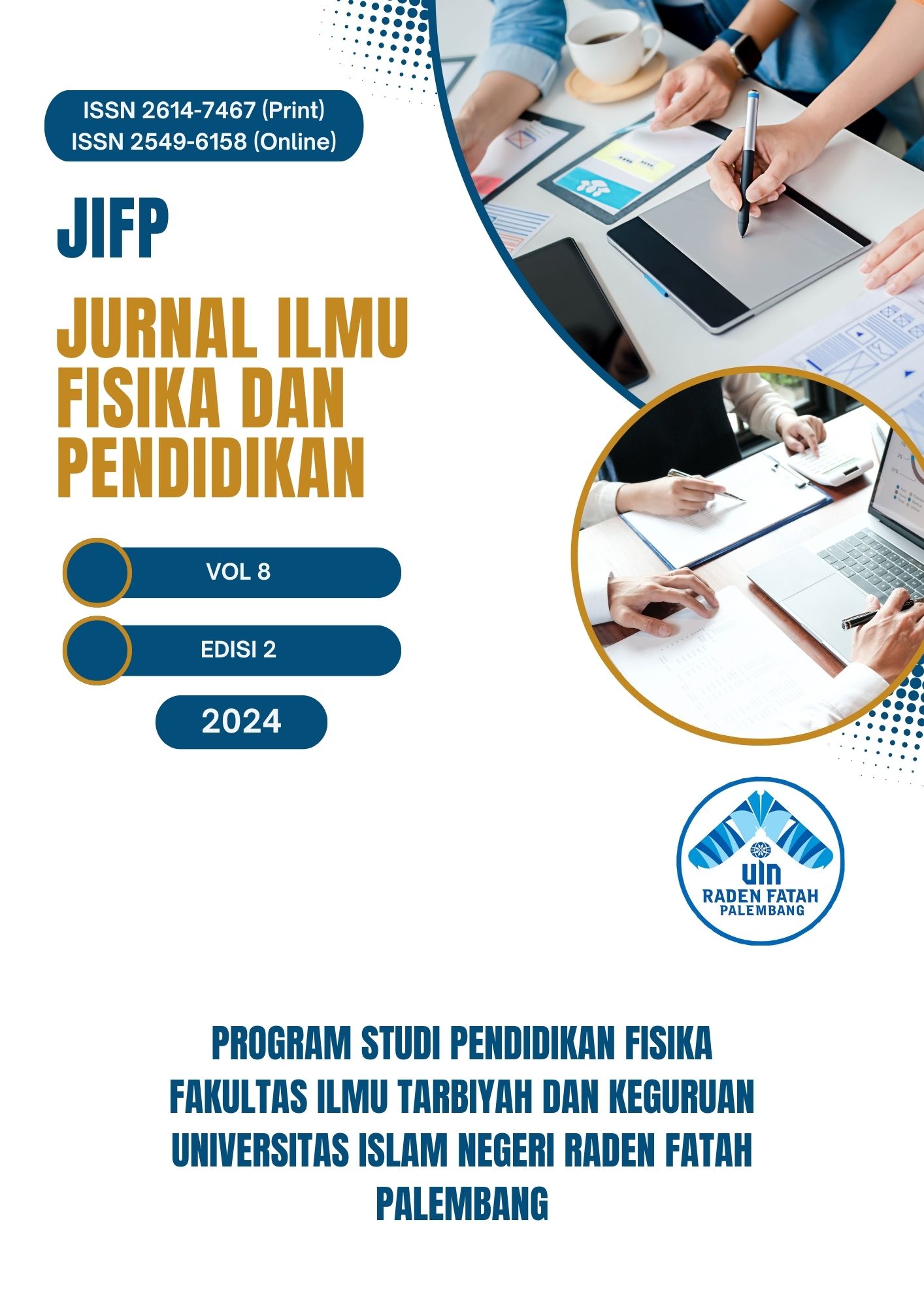Analysis of Extreme Rainfall in The Maluku Islands And its Relationship with The ENSO Phenomenon
Main Article Content
Abstract
Global climate anomalies can cause extreme climates, especially in Indonesia, one of which includes extreme rainfall events. Rainfall in Indonesia itself is coherent and correlated with ENSO variations in the Pacific Ocean. Apart from the influence of ENSO, there are other influences such as regional, local factors and regional topography which also greatly determine the characteristics of rainfall, especially in the Maluku Islands which have different rainfall patterns from other areas in Indonesia. The complex phenomena that influence rainfall in the Maluku region attract the attention of researchers to analyze extreme rainfall patterns and their relationship to ENSO relationships. This research uses daily rainfall data at BMKG and Metomanz stations from 1992 to 2022 for 30 years, and uses a simple linear regression method obtained from the results of ERA 5 reanalysis data with BMKG data, at stations that do not have complete data for 30 years. This research was conducted using the Mann-Kendall and Sen's Slope methods. The Mann-Kendall method is used to determine the degree of significance and change in positive or negative direction. Meanwhile, the Sen's Slope Method is used to determine the magnitude of the linear slope of the resulting trend. Extreme climate patterns in the Maluku Islands are influenced by the ENSO phenomenon and geographical conditions of the region. There are significant trend changes in CDD, CWD, and PRCPTOT. The Rnmm index is divided into three index limits (R20mm, R15mm, and R10mm). Increasing trends of CDD, CWD, PRCPTOT, occurred sequentially at Mathilda Batlayeri, Kuffar, Bandaneira stations. The Rnmm index is divided into three index limits R20mm, R15mm, and R10mm and there is a sequential increasing trend at Bandaneira, Namlea and Mathilda Batlayeri stations
Downloads
Article Details
How to Cite
References
Aldrian, E. & Dwi Susanto, R. (2003). ‘Identification Of Three Dominant Rainfall Regions Within Indonesia and Their Relationship to Sea Surface Temperature’, International Journal of Climatology, 23(12).
Ariska, Melly, dkk. (2022). Prediksi Perubahan Iklim Ekstrem di Kota Palembang dan Kaitannya dengan Fenomena El-Niño Southern Oscillation (ENSO) Bebasis Machine Learning. Jurnal Inovasi Pendidikan Fisika dan Riset Ilmiah. Vol. 6 No. 2.
Biloro, J., Patty, J.R. and Laimeheriwa, S. (2021) ‘Analisis Kondisi Iklim dan Pemanfaatannya untuk Penetapan Musim Tanam di Daerah Batabual Kabupaten Buru’, Jurnal Pertanian Kepulauan, 5(2), pp. 111–126.
Bimaprawira, A.K., & Rejeki, H.A. (2021). Keterkaitan Prioritas Curah Hujan Di Daerah Pesisir Dan Pegunungan Provinsi Jawa Timur Dengan Variabilitas Cuaca Skala Global Dan Regional. Jurnal Sains & Teknologi Modifikasi Cuaca. Vol.22 No.2
BMKG. (2018). La Niña, El Niño Dan Musim di Indonesia, Badan Meteorologi Klimatologi Dan Geofisika.
Darmawan. (2021). Buku Tren Hujan, Badan Meteorologi Klimatologi dan Geofisika.
Faudzan, A., Suryani, S., & Budiawati, T. (2015). Perbandingan Metode Inverse Distance Weighted (IDW) dengan Metode Ordinary Kriging untuk Estimasi Sebaran Polusi Udara di Bandung. E-proceeding of Engineering: Vol. 2.
Gutman, G., Csiszar, I. & Romanov, P. (2000). ‘Using NOAA/AVHRR Products to Monitor El Niño Impacts: Focus on Indonesia in 1997-98’, Bulletin of The American Meteorological Society, 81(6).
Hidayat R, Ando K. 2014. Variabilitas curah hujan Indonesia dan hubungannya dengan ENSO/IOD: Estimasi menggunakan data JRA-25/JCDAS. J Agroment Indonesia. 28 (1):1-8
Holton, J.R & Wallace, J.M. (1971). On Boundary Layer Dyanamics and the ITCZ.
Indra. (2023) ‘Thunderstorm Predictions Using Artificial Neural Network Perceptron Method With Radiosonde Indices in Tanimbar Island Regency Area’, 14(2), pp. 32–38. Indriyati, L. and Mahanani, U. (2024) ‘Pengaruh La Niña Dan El Niño Terhadap Penyakit Demam Berdarah Dengue Dan Malaria Di Indonesia’, EnviroScienteae, 20(1), p. 90.
Laimeheriwa, S. (2014). ‘Analisis Tren Perubahan Curah Hujan Pada Tiga Wilayah Dengan Pola Hujan Yang Berbeda Di Provinsi Maluku’, Jurnal Budidaya Pertanian, 10(2), Pp. 71–78.
Lestari, D.O. et al. (2018) ‘Respective Influences of Indian Ocean Dipole and El Niño-Southern Oscillation on Indonesian Precipitation’, Journal of Mathematical and Fundamental Sciences, 50(3), pp. 257–272.
Mabruroh, F. & Wiyanto, A. (2023) ‘Analisis Fenomena Perubahan Iklim Terhadap Curah Hujan Ekstrim’, 7(1), P. 94.
Risamasu, R.G. et al. (2023) ‘Analisis Perubahan Curah Hujan Dan Pemetaan Zona Agroklimat Oldeman Pulau Seram Provinsi Maluku’, Journal Of Social Science Research, 3(3), pp. 1010–1024.
Santoso, A.B. (2016) ‘The Impact of Climate Change on Food Crops Production in the Province of Maluku’, Penelitian Pertanian dan Tanaman Pangan, 35(1), pp. 29–38.
Supari. (2012). ‘Spasio Temporal Characteristic of Extreme Rainfall Events Over Java Island, Case: East Java Province’, The Indonesian Journal of Geography, 44(1), Pp. 62–86.
Tentua, E., Laimeheriwa, S. and Patty, J.R. (2022) ‘Analisis Musim Tanam dan Pengaturan Pola Tanam Tanaman Pangan pada Berbagai Kondisi Curah Hujan di Daerah Amahai Kabupaten Maluku Tengah’, Jurnal Pertanian Kepulauan, 6(1), pp. 23–37.
Trenbeth, K.E., Caron, J.M., Stepaniak, D. P., & Worley, S. (2002) ‘Evolution Of El Niño-Southern Oscillation and Global Atmospheric Surface Temperatures’, Journal of Geophysical Research D: Atmospheres, 107(7–8), Pp. 5–1.
Wang, C., Deser, C,. Yu, J.Y., DiNezio, P., & Clement, A,. (2016). ‘El Niño and Southern Oscillation (ENSO): A Review’, Pp. 291–3
Wirjohamidjojo, S., & Swarinoto, Y., (2010). Iklim Kawasan Indonesia (Dari Aspek Dinamik - Sinoptik), Badan Meteorologi Klimatologi Dan Geofisika.
Yuniasih, B. et al. (2023) ‘Anomali Iklim El Niño dan La Niña di Indonesia pada 2013-2022’, 6(2), pp. 136–143.

